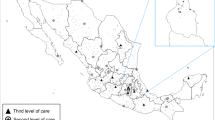Abstract
To analyze the benefit of a departmental IT group in comparison to support by hospital IT groups or system manufacturers in a completely digitized radiological department. The departmental IT group comprises a fulltime IT specialist, two student assistants and four clinical employees participating 1 day/week. For 18 months IT problems were quantified and specified according to urgency, responsibility and affected system by use of an intranet-based reporting system. For each IT service provider the performance and duration of problem solution was evaluated. In 18 months 3,234 IT problems emerged. 88.7% were solved by the departmental IT group. In 474 cases (14.7%) a solution within 2 h was required. The departmental IT group solved 35.8% within 30 min, system manufacturers needed 18 h 38 min in mean. The departmental IT group solved 90.2% of the problems within a time limit. System manufacturers met the limit in 60.1% with a mean duration of 7 days 21 h. In 6.7% of the cases, support by system manufacturers was indispensable. A considerable proportion of IT problems in completely digitized radiological departments can be solved by a departmental IT group, providing a fast and cost-efficient first-level IT support with effective prevention of major breaks in the workflow. In a small number of cases support by system manufacturers remains necessary.






Similar content being viewed by others
References
Bick U, Lenzen H (1999) PACS: the silent revolution. Eur Radiol 9:1152–1160
Langen H, Bielmeier J, Wittenberg G, Selbach R, Feustel H (2003) Workflow improvement and efficiency gain with near total digitalization of a radiology department. Rofo Fortschr Geb Rontgenstr Neuen Bildgeb Verfahr 175(10):1309–1316
Boochever SS (2004) HIS/RIS/PACS integration: getting to the gold standard. Radiol Manage 26:16–24; quiz 25–17
Foord K (1999) PACS: the second time around. Eur J Radiol 32:96–100
Siegel EL, Reiner BI, Cadogan M (2000) Frequency and impact of high-resolution monitor failure in a filmless imaging department. J Digit Imaging 13:114–118
McBiles M, Chacko AK (2000) Coping with PACS downtime in digital radiology. J Digit Imaging 13:136–142
Liu BJ, Huang HK, Cao F, Zhou MZ, Zhang J, Mogel G (2004) Informatics in radiology (infoRAD): a complete continuous-availability PACS archive server. Radiographics 24:1203–1209
Arenson RL, Andriole KP, Avrin DE, Gould RG (2000) Computers in imaging and health care: now and in the future. J Digit Imaging 13:145–156
Haugh R (2001) Sharing the IT pain. Hosp Health Netw 75(8):34–37
Blado ME, Tomlinson A (2002) Monitoring the accuracy of a PACS image database. J Digit Imaging 15(Suppl 1):87–95
Lannum LM, Gumpf S, Piraino D (2001) Tools to manage the enterprise-wide picture archiving and communications system environment. J Digit Imaging 14:17–21
Mensch B, Honea R, Orand M (1999) Care and feeding of a staff for filmless radiology. J Digit Imaging 12:38–40
Honeyman-Buck J (2003) PACS adoption. Semin Roentgenol 38(3):256–269
Himes JA, Rosenfeld K (2004) Integrating digital systems: commitment and collaboration. Radiol Manage 26:28–30
Ralston MD, Coleman RM, Beaulieu DM, Scrutchfield K, Perkins T (2004) Progress toward paperless radiology in the digital environment: planning, implementation, and benefits. J Digit Imaging 17:134–143
Hasley T (2002) PACS support: the radiology approach. Radiol Manage 24:26–30
Mazurowski J (2004) Informatics management and the PACS administrator. Radiol Manage 26:41–42
Staley S, Romlein J, Chacko AK, Wider R (2000) Planning factors for developing an enterprise-wide picture archiving and communication system maintenance program. J Digit Imaging 13:228–229
Mace J (1998) Asset management in theory and practice. Radiol Manage 20(3):16–21
David G, Burnett L, Schenkel R (2004) Linking radiology equipment service and medical physics survey databases. Radiol Manage 26(1):22–25
Gordon M, Morgan T (1985) Implementing an in-house radiological equipment service program. Radiol Manage 7(4):31–38
Bliznakov Z, Pappous G, Bliznakova K, Pallikarakis N (2003) Integrated software system for improving medical equipment management. Biomed Instrum Technol 37(1):25–33
Birjandi A (2004) Essentials of a good RIS/PACS contract. Following the rules of engagement in negotiating a partnership can prevent surprises or disappointments in a RIS/PACS implementation. Health Manag Technol 25:34–37
Brown CL, Howarth SP (2004) The power of picture archiving and communication systems: strategic hospital considerations. J Healthc Inf Manag 18:19–26
Honea R, Mensch B (1999) Maintaining continuity of clinical operations while implementing large-scale filmless operations. J Digit Imaging 12:50–53
Honea R (2001) How many people does it take to operate a picture archiving and communication system? J Digit Imaging 14:40–43
Payne T (2002) Full circle to in-house facilities services. Health Estate 56(7):41–45
Deinstadt D (2003) Does your equipment maintenance management program measure up? Radiol Manage 25(4):36–39
(2004) The digital evolution: secrets of success when transitioning from the analogue to the digital environment. Eur Radiol 14(7):1331–1339
Acknowledgements
The authors would like to thank Mrs. A. Lucke for her excellent support of the departmental IT group.
Author information
Authors and Affiliations
Corresponding author
Additional information
This work was orally presented on ECR 2004 in Vienna.
Rights and permissions
About this article
Cite this article
Treitl, M., Wirth, S., Lucke, A. et al. IT services in a completely digitized radiological department: value and benefit of an in-house departmental IT group. Eur Radiol 15, 1485–1492 (2005). https://doi.org/10.1007/s00330-004-2609-5
Received:
Revised:
Accepted:
Published:
Issue Date:
DOI: https://doi.org/10.1007/s00330-004-2609-5




